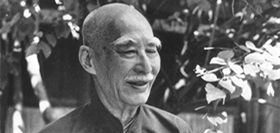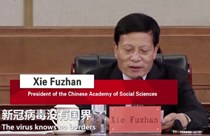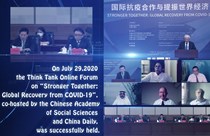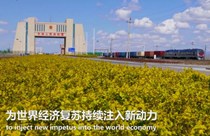National interests primary in regional relations of Asia-Pacific
Author : Xiong Lili Source : Chinese Social Science Digest 2014-09-10
The topic of symbiotic international relations has been researched a lot in China in recent years, centering on the source, basic conditions and cultural meaning of the symbiotic system in addition to historic “symbiotic relationships” in the Asia-Pacific.
Research findings suggest that a symbiotic international system is attributed to the symbiosis of domestic societies and human sociality. Symbiotic international relations exist and endure on account of shared interests and related common cognition of countries involved.
Existing “symbiosis” theories pinpoint the principle of state sovereignty as the prerequisite for the symbiosis of international relations. However, the principle manifests nothing but high respect to and protection of national interests.
For as long as 70 years since World War II, sovereign states remain the most important actors of the international system, while non-state actors, such as international organizations, have increased sharply both in number and influence.
Valuing and respecting the independence of sovereign states, the contemporary international system is virtually acknowledging their independent will that distinguishes them from other actors because of their respective interest demand. The prevailing sovereignty system of the modern-day world is a reality check for the individuality of countries’ interests.
Competition throughout history
A review of Asia-Pacific history indicates that the complete picture of the millennium before the 19th century will never be accurately presented in a narrow view of the “symbiotic system” built upon shared interests and ideas of countries in the region.
Before the Asia-Pacific was regularized by the maxim of international relations featuring sovereign equality and mutual respect to territorial integrity in modern times, relationships between regional countries were either characterized by “competition,” “confrontation” or “dependency” due to disparities between their strengths.
Even though they existed on equal footing and engaged in “symbiotic” relationships in relative peace, they were actually in a phase of transition between “competition” and “dependency.”
Prior to the introduction of the modern principle of sovereignty, especially in the latter half of the 17th century and the first half of the 19th century, there was apparently peace and stability in the Asia-Pacific.
However, this was not due to the so-called “symbiotic system.” The fact was that the Qing Dynasty (1644-1912) court was so dominant in the region that international competition was dampened to some extent. When the court’s dominant position was destroyed by Western powers in the mid-19th century, the tributary system fell apart as a matter of course.
By the late 19th century when independent states in the Asia-Pacific were far and few between, Japan increasingly competed against China instead of fostering a “symbiotic” relationship.
In the first half of the 20th century, it was Japan that invaded China, its neighbor, as the main force, rather than powers from Europe or America.
Only through World War I and II was the principle of sovereignty gradually recognized throughout the region alongside mounting destructiveness of military technology and growing economic interdependency among the countries.
These factors combined transformed the traditional competition- and dependency-oriented system of the Asia-Pacific into one characterized by competition and cooperation.
From the late 1940s to the 1970s, Asia-Pacific countries that were colonies or dominions of Britain, France, the US and the Netherlands gained independence one after another. Progressively, the region has shaped a modern system of sovereign states.
As mentioned above, the principle of sovereignty is built upon full respect to and protection of individual countries’ interests. Meanwhile, painful memories of World War I and II along with terrifying consequences of nuclear wars considerably restricted those countries’ motive for conflict. To avoid war and maintain peace therefore become a shared criterion of value and common interest appeal.
Although the international community, military technologies and economic exchanges, with their positive and negative effects, have equipped the present Asia-Pacific international system with a much more profound base of common interests, ideas and cognition than the traditional order in East Asia, there is little likelihood that the never-realized “symbiotic system” will come true in the region.
For the sake of common good, Asia-Pacific countries have been quite cooperative in recent years, which is a result from their shared interests and a channel to cement the base of common benefits.
Idealists might simply equate the cooperativeness to “symbiosis” and replace competition in favor of cooperation. However, as long as the system of sovereign states remains effective in the Asia-Pacific, it is impossible the interests of individual countries will be surrendered to the common interests of the system.
US and Japan as examples
As far as cooperation in the Asia-Pacific is concerned, the evident progress is nevertheless unable to weaken, let alone eliminate, the individuality of sovereign states. Conversely, the presence of a variety of phenomena in the region fully shows that the countries cooperate to promote common interests as a way of maximizing their own interests. This is to be exemplified by the US and Japan, the first- and third-world economies, as follows.
When US President George W. Bush was in office, Washington placed its major strategic focus on anti-terrorism in the Middle East with little attention paid to the Asia-Pacific. It was not until the country lost its influence in the region and China quickly rose to prominence that the US found its strategy toward the Asia-Pacific had been out of balance.
Drawing lessons from his predecessor’s negligence, Barack Obama put forward the “Rebalancing toward the Asia-Pacific” strategy shortly after he came into power.
Since then, the US has tried every means to regain ground in the region. In addition to adjustments to military deployment in the Asia-Pacific, the country vigorously propagates the Trans-Pacific Partnership Agreement (TPP) in a bid to supersede regional cooperative mechanisms like “10+3” and “10+6” that exclude the US, thus realizing its strategy and economic interests.
In Japan, Shinzo Abe’s government has pursued Asia-Pacific policies aimed at containing China. By joining the TPP, Tokyo not only attempts to strengthen strategic coordination with the US, but also hopes to isolate China in the cooperation process of the region.
Japan, shored up by its massive economy, will be facilitated to reap first-move advantages in rulemaking, therefore securing a bigger say in the formation process of the TPP mechanism.
It can thus be seen that the influence of different and even opposing interests of Asia-Pacific countries is no weaker than that of their common benefits. That is why multiple mechanisms complexly exist in the Asia-Pacific. Within the various mechanisms, interest relationships among the countries are equally complex.
The Asia-Pacific is to date yet to enter the initial state of regional economic integration through free trade, which is a reality sign of the competition among individual interests of the countries.
The author is an associate professor at the School of International Relations at the University of International Business and Economics.
Translated by Chen Mirong
Revised by Tom Fearon
Ye Shengtao made Chinese fairy tales from a wilderness
Ye Shengtao (1894–1988) created the first collection of fairy tales in the history of Chinese children’s literature...
-
How northern ethnicities integrated into Chinese nation
2023-09-18
-
Mogao caves
2023-09-12
-
Mogao Grottoes as ‘a place of pilgrimage’
2023-09-12
-
Time-honored architectural traditions in China
2023-08-29
-
Disentangling the civilizational evolution of China
2023-08-28
-
AI ethics in science fiction
2023-08-23














 2011-2013 by www.cssn.cn. All Rights Reserved
2011-2013 by www.cssn.cn. All Rights Reserved